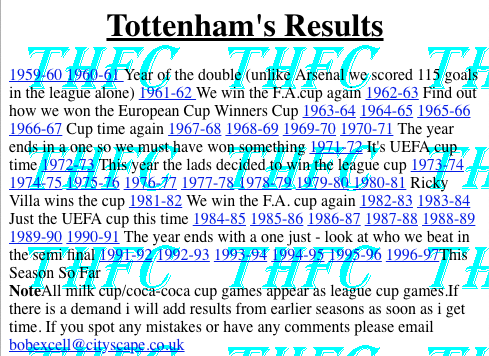Introduction
To begin, this article won't make much sense if you don't know the difference between the Internet (capital I) and the Web (capital W). There are definitions at the bottom of this page but the TL;DR version is that the Internet is the 'hardware' that connects the world's computers together, and the web is the 'software' that runs on it.
I couldn't tell you the first time I heard of the Web, but the first time I accessed it was in 1997. It was at the opening of Simply Computers' new warehouse and store on Blackhorse Road in London. Although I don't remember the exact date, I do remember that Gary Mabbutt (former Tottenham Hotspur team captain) was the 'celebrity' who was invited along to cut the ribbon so for me, as a Spurs fan, this was a bonus. Simply were the first people I bought PC hardware from, specifically a CD-ROM drive and a Sound Blaster AWE32 (and probably some RAM). At the event they had a room tucked away with a bunch of PCs made available for 'surfing the web'. I don't know if you've heard of Web 2.0, but that didn't happen until about 2002 - this was very much Web 1.0.
This article has been made possible by the amazing efforts of archive.org's WayBack Machine, an archive of the Web's history since 1996.
Web 1.0
The initial format of the Web largely comprised static pages of information provided by companies, corporations and organisations. Designs were simplistic owing to HTML having not been developed significantly and were characterised by the Times New Roman font, low res images (if any) and tiled backgrounds. Here's what Yahoo looked like in October 1996:
 |
| Yahoo |
 |
| AltaVista |
 |
| Apple Computer |
One of the most remarkable things was the amount of screen real estate these pages used. These images are the actual size of the web page as it is displayed. Most were designed with an 800 x 600 pixel resolution in mind, if not 640 x 480. That's certainly the resolution I was using with Windows 95 until I upgraded my monitor in 1999. It could also be said that 'web sites' weren't really a thing either. These were homepages in the truest sense of the word. Check out id Software's site:
Quite impressive by comparison. I like how much mood they've managed to get in there, despite the limitations of the technology. Note the 'text only' option.
But it wasn't all big business and corporations. There were a small number of hosting services at this time, such as Demon and Cityscape, who provided an enormous 1MB of space for individuals to showcase their own nascent web design skills. Here are some classy examples.
 |
| The Animated Reid Family Homepage |
 |
| Check Spurs Results Year by Year |
You can check out the full list of sites here and it really is worth spending some time scrolling through and looking at what was on offer. The ones above are actually relatively bearable and informative compared to some. The struggle between content and appearance (and legibility) has been waged for an eternity. The site below is much more like the kind of thing people would produce with their newly-learned html skills:
Just because you can doesn't mean you should. Yep, garish was the style of the day, along with obligatory 'under construction' message (made with WordArt, I believe). There were some semi-useful pages though, striking that balance between form and function pretty well:
 |
| Sean O'Connor's Windows Games |
Notice the multiple download links in the site above. When the Internet itself was still relatively slow, there were geographical considerations when downloading large files. With intercontinental links still developing, it was usually significantly faster to download a file that was located closer to your own country than one on the other side of the world. The longer the distance, the higher the likelihood of dropped packets, which exponentially increased the time it would take to complete a download.
That's all for part one. Part two will look at when I got my own Internet connection for the first time and created my very own website...
Glossary
The Internet (noun): also called 'the Net', a worldwide network of smaller geographically-limited computer networks. Originally ARPANET, a communications network linking U.S. government facilities and universities / research centres. Established in 1969, it was the first network to use the TCP/IP (packet data) protocol. It differs from the basic model of a WAN in that there are multiple geographical routes to any node on the network rather than one. This betrays the vulnerability of physical network links, and the need to build in redundancy in the case of a failure. Traffic is directed by devices called routers, utilising Dijkstra's algorithm (among others) to calculate the shortest path between a start and a destination, potentially with multiple 'jumps' on the way.
The World Wide Web (noun): also called 'the Web', a virtual space for sharing information, utilising the Internet to communicate data and using hypertext to link resources with Uniform Resource Locators (URL) to provide an address (web address).

